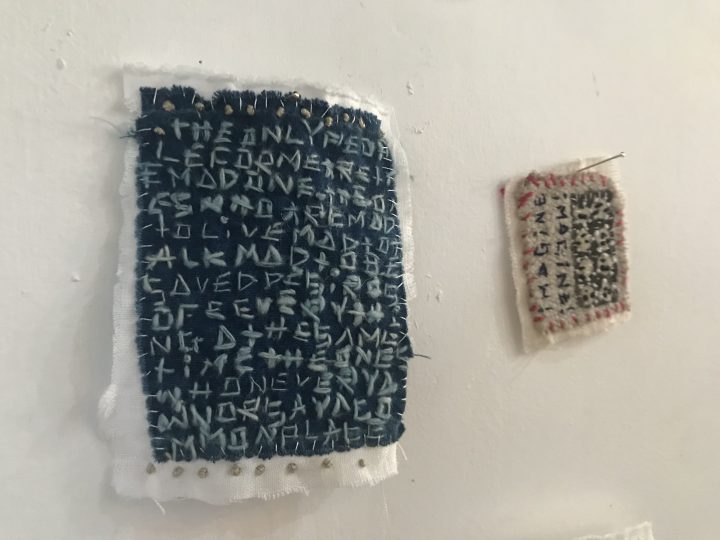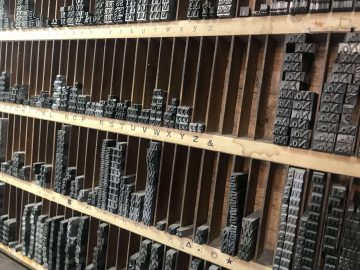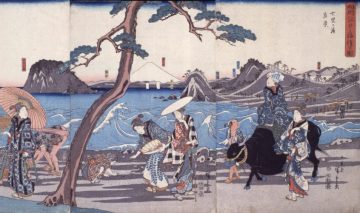Interview with Aiko Miyanaga: "A Port in Transition: Many Times"
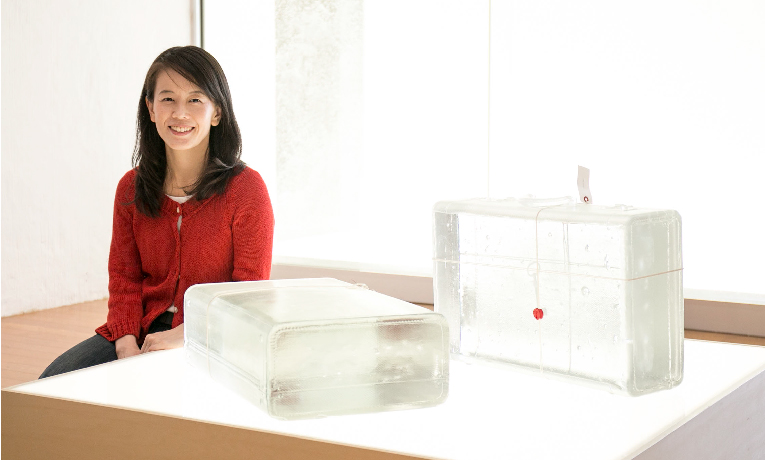
Interview by Masanobu Nishino Text by Akiko Inoue
The Nissan Art Award is currently being held at BankART studio NYK. This is the first time this year that this contemporary art award is held every two years, and the Grand Prix and the Jury Special Award were recently selected from among the eight finalists. We spoke to Aiko Miyanaga, who won the first Grand Prix. Miyanaga's exhibition space is a space that opens to the outside from the balcony on the second floor of BankART studio NYK, overlooking the harbor. The work in the large glass case room is located just between the inside and outside. When viewing the exhibition, on the way from the inside to the outside, the hustle and bustle of the harbor fades in pleasantly to the ears from around the glass case. Then, when you go outside, the scenery spreads out before your eyes along with the sound of the wind and the cries of seagulls. It is not a spectacular view, but the continuous time of "now" itself.
The port town visible across the sea was bustling with people that day as well.
We met Miyanaga at the exhibition venue and spoke to him at the cafe on the first floor. After periods of intense concentration, there are brief moments of calm. He answered our interview questions while exuding a gentle, comfortable time that was similar to relaxation.
Cooperation: BankART studio NYK
— The time of "history" that the port town has nurtured / the superficial time of "now" —
—Congratulations on winning the Nissan Art Award 2013 Grand Prix.
First, please tell us about the concept of your award-winning work, Letter.
In art, I think there are people who create things inside this object (pointing to the cup he was drinking from), but I like to create the entire space, so I first come to the place and think about what I want to use and then create. In this case, what I found most attractive was the view of the port and the view beyond the port. People are always moving, fish are jumping, windmills are turning and changing. There is a view beyond that where you can see that the time of the surface = the time of the "now" is moving, and I wanted to use this in my work first. Then, how can I create that space and use that place effectively? I think about the fact that the "time" of the scenery that is moving now has a "time" that goes back, such as the time of history. How did this port start, and why was the current time on the surface created? I wanted to create an exhibition that would make the viewer think about such things without having to explain them, so I started creating my work.
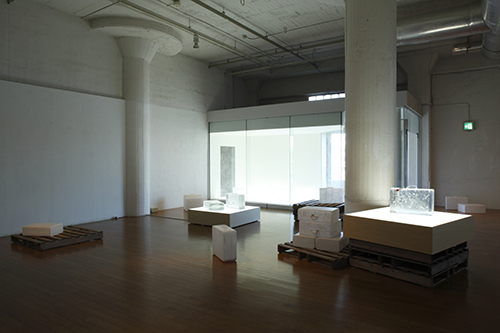
Naphthalene, resin, sealing wax, trunk, mixed media
Photo: Keizo Kioku © MIYANAGA Akko / Courtesy Mizuma Art Gallery
—That 's true. I was conscious of the scenery outside while looking at Miyanaga's latest exhibition.
The exhibition is in a room, but the exhibition location is not just one part of the room, but the entire space surrounding the exhibition location, so the space used is the room where the items are placed, the passage leading to the room, and the balcony outside the room. By using three views in this way in the exhibition, the viewer can unknowingly feel that a more distant view is also incorporated into the work.

The trunk used in the work is placed on the balcony, and behind it is a view of the port with many ships and people passing by. (Photo: MAGCUL)
— Personal time accumulated in “things” —
- A trunk is used as one of the motifs in this work. What is the intention behind this?
I wondered how to create a work that would make the viewer think about the time that flows there, and this time I used a trunk as a motif. Originally, BankART studio NYK was a warehouse, so I thought it would be good to have something that would make the journey start from here, but it's not just something that goes out, but also something that comes in. When I came to check it out, there were a lot of pallets stacked outside, so I decided to use some of them in the exhibition and created a landscape (= installation) that would give the viewer an image without having to explain a lot of things.

Naphthalene, resin, sealing wax, trunk, mixed media
Photo: Keizo Kioku © MIYANAGA Akko / Courtesy Mizuma Art Gallery
-This time it was a trunk, but you often use everyday items as models. What is your intention behind these selections?
I choose things that everyone knows, rather than special things, because they are easy to connect with each person's memories when they are seen. For example, in the case of shoes, you can see the accumulation of the person's time in the wrinkles and the hem. In that case, it is an object, but it is not an object, but it feels like a person. I don't want to make a mold of the human body with naphthalene. I think that even without doing that, you can feel a person enough with just a single key. That's the intention behind choosing motifs.
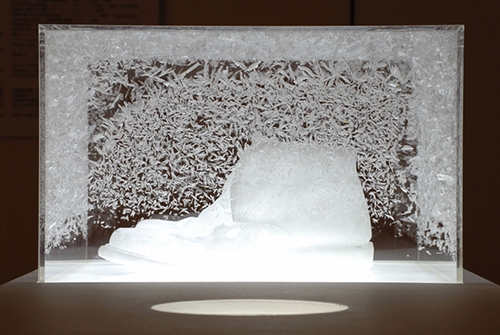
Naphthalene, mixed media
Photo: Norihiro Ueno © MIYANAGA Akko / Courtesy Mizuma Art Gallery
— What the material teaches us. My encounter with naphthalene —
- You often use naphthaline in your works. Could you tell us about your work in the glass room located between the balcony and the interior?
Those who come for the first time may think that there was originally a glass room, but it was actually a passageway (windbreak room) and by adding three pieces of glass it was made to look like a room. I created a space where you can see the process in which Naphthalene's work changes. This is the largest glass case work I have ever done. All the things in the room are "encapsulated" and there is not a single piece of Naphthalene exposed. All that is provided for the viewer is the opportunity.
—What prompted you to start using naphthalene in your work?
When I was thinking about what to do for my graduation project in my fourth year of university, I was changing the clothes in my dresser with my mother, and I found two bags of naphthaline, leaving only the round shape in the bag, and I thought, "If I can make a work with this, I can make a work that disappears." Since I was in the sculpture course, I wondered if anyone else had made a sculpture that disappears, and I wanted to try it.
—What is implied in the title “Letter”?—
-You mentioned the word "enclosed" earlier, and there is a work in which a key-shaped naphthaline is "enclosed" in a trunk. I heard that there is some kind of mechanism behind it.
The transparent resin trunk work contains naphthalene, but if you look closely you will see that a small air hole is sealed with red wax seal. If you remove the red wax seal, the naphthalene will begin to sublimate little by little, and the key will appear as an absent form over a long period of time. In other words, the same thing is happening inside the glass case.
-The title of this exhibition is "Letters."
Yokohama is an old port town, and everyone knows that it was the port where Western culture entered. I'm sure that along with the distribution of goods, it was also a place where the hopes and dreams of people starting new things intersected. The current scenery is the continuation of that history, and the future scenery will be connected to that continuation. The various trunks carried from the port depart for a faraway country carrying someone's thoughts, and arrive here again carrying someone else's thoughts. In the midst of the scenery that changes every day, I thought about the time that has passed through history, and chose the title "Letters."
— What to expect from future awards —
—Until now, I think there haven't been many opportunities in Japan to gather contemporary art works and hold awards.
What are your expectations for an exhibition like this?
In Japan, once you turn 35, the opportunities to participate in awards and overseas dispatch programs decrease. This exhibition has no age limit, and I exhibited alongside artists who are active on the front lines, so it was a good experience. I was also happy to have an overseas curator see my work directly. Above all, I am grateful that they faced contemporary art, "works emerging from this era," rather than objects that have already been evaluated. When it comes to corporate support, it is easy to be preoccupied with improving the company's image, but this time there was support for a variety of works. I think that if we continue this for many years, the layer of "the present" will become visible in the overlapping layers.
Kanagawa's recommended places
"LA MAREE DE CHAYA La Mare de Chaya (Hikage Chaya) Hayama Main Branch"
We would like to introduce the cakes "Fraise" and "Catherine" from LA MAREE DE CHAYA, recommended by Aiko Miyanaga. Since we had the chance, we visited the main store in Hayama for an interview. When you get off at the fifth bus stop called Abuzuri from Zushi Station, you will see the sea in front of you and a coffee shop that looks like a European country house. This is LA MAREE DE CHAYA's patisserie specialty store. Although the desks and shelves in the store have a sense of age, you can tell that they have been treated very carefully, and you can feel the dignity that only a brand that has been loved for a long time can have. However, the store's quiet appearance is also good. The "Fraise" and "Catherine" recommended by Miyanaga seem to be classic choices, and the showcase in the store was packed with dozens of cakes arranged with seasonal fruits. It is also nice that such a colorful cake can be purchased for only 400 yen.

In addition to the patisserie, LA MAREE DE CHAYA also operates a Japanese restaurant, a French restaurant, and a Japanese sweets specialty store. It is located near the same Abuzuri bus stop, so if you visit Hayama, be sure to stop by.
CHAYA | Hikage Chaya Official Website http://www.chaya.co.jp/index.html
